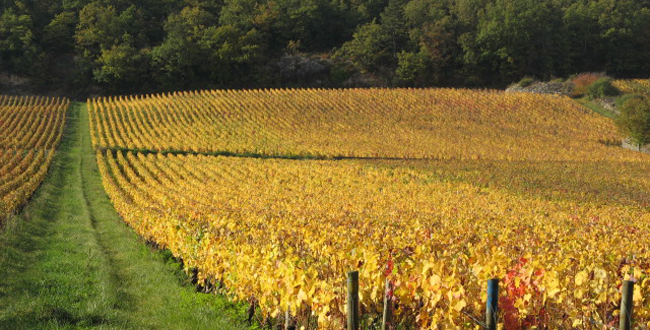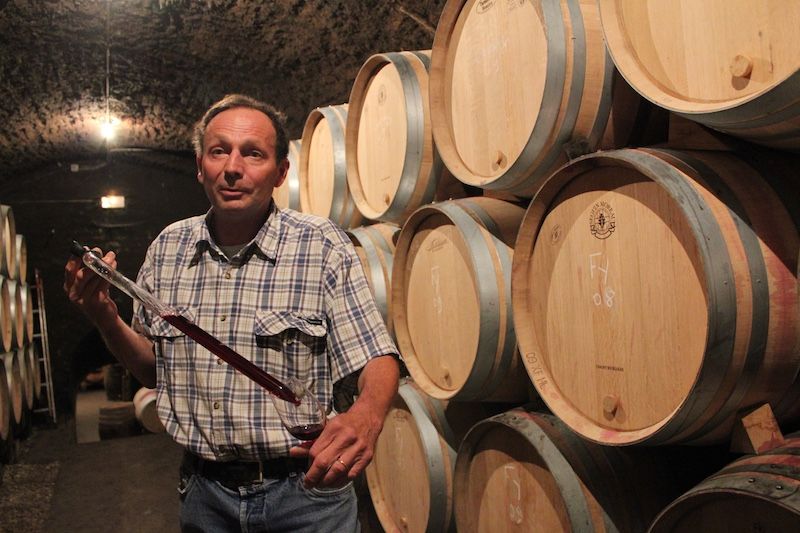Bruno Clair estate
Bruno Clair is the grandson of Joseph Clair, from Santenay, and Marguerite Daü, from Marsannay, whom his grandfather met during his time in the barracks in Dijon during the First World War. Bruno set up home against a backdrop of family discord, and began by creating his own vineyard, replanting in Marsannay and clearing land above the hillside of Morey-Saint-Denis. Part of the family vineyard was sold by a family member to Louis JadotIn the mid-1980s, the rest fell to Bruno, who soon hired a former colleague, Philippe Brun, to help him in the cellar. Together, they developed a parcel of ha and as many different wines, having acquired new vines in 2006 when certain contracts signed with Louis Jadot (vosne-romanée, gevrey-chambertin Clos Saint Jacques and chambertin-clos-de-bèze) and domaine Fougeray de Beauclair (bonnes-mares) came to an end.
In 1993, the estate expanded its vineyards to include the following appellations: Corton-CharlemagnePernand-Vergelesses, Aloxe-Corton and in 1996, Gevrey-Chambertin Little Chapel.
Winemaking
As regards vinification, the estate carries out rigorous sorting in the vineyard, then de-stems the grapes (with a few exceptions, as in 2005). Philippe Brun is in favor of punching down the cap, but he modulates his convictions according to the vintage: in 2007, he only needed to punch down the cap once a day, as opposed to the usual five or six times. The domaine doesn't skimp on new barrels, but ages a good proportion of its villages in foudres for some time to avoid over-oaking the wine. In the end, the wines are powerful, but not over-extracted.
Estate wines
Aloxe Corton
Bruno Clair's Aloxe Corton cuvée comes from two different parcels. Les Crapoussuets" and "Les Valozières" are located mid-slope on the Corton hillside. This wine is the very image of its appellation. It always has a great tannic character, and is very robust in its early years. It's a wine for laying down.
Morey-St-Denis Blanc "En la rue de Vergy
This is a very unusual vineyard, as it is planted directly on the limestone bedrock. There's no soil to be found. It's one of the rare white wines of the Côte de Nuits. This Morey-Saint-Denis is fragrant, with a strong mineral character. This wine can be laid down and enjoyed young, with no nasty surprises!
Gevrey-Chambertin
Bruno Clair's Gevrey-Chambertin cuvée is made from two parcels: Les Carrougots and En Jouise. The vines are planted here on rich soil. The personality of this wine in its youth is rather austere and tannic. This Gevrey needs several years of cellaring to mature. All the more so as it has great cellaring potential!
Gevrey-Chambertin 1er Cru Clos du Fonteny "Monopole
This vineyard was planted in two stages: one half in 1972, the other in 1987. This wine has finesse and great elegance. You'll also notice the power of this Gevrey-Chambertin. It can be kept from 5 to 15 years.
Gevrey-Chambertin 1er cru "Clos Saint Jacques
The vines were planted in 1957 and 1972. Until 1999, the cuvée was sold under my mother's label, "domaine G. Bartet". The wine makes an immediate impression with its sumptuously rich aromas of red and black fruits, but is also capable of long aging.
Chambolle Musigny "Les Véroilles
The vines were planted in 1989 and have been producing fine, silky Chambolle ever since. As the years go by, the roots go deeper and deeper, producing wines of great breadth and depth. These are highly perfumed, textured wines. These Chambolle-Musigny wines can be drunk young, but they can also be laid down perfectly for several years.
Vosne-Romanée "Les Champs Perdrix
This terroir is undoubtedly very difficult to work. The vines were planted over a very long period, around 30 years. The soil was very poor, and until the 1993 vintage, these Vosne-Romanée wines lacked both roundness and finesse. But since then, a new quality has developed in these wines, which have become finer and more harmonious. For ageing, this wine is ideal after 10 years, but it will already be very surprising after 3 / 4 years.
Corton Charlemagne Grand Cru
The stunning acidity in harmony with the great ripeness of this wine gives it its uniqueness. It's a great wine that combines minerality and power. It's a wine for laying down that will need at least 5 to 7 years to develop all the aromas worthy of a grand cru.
Grand Cru Chambertin "Clos de Bèze
The plots are in the middle of the Grand Cru, their rows running from the top to the bottom of the Clos. Two-thirds of the vines date back to 1912, with the remainder planted in 1972. The wine is exceptional, in keeping with its prestigious terroir, and deserves cellar aging worthy of the name.
Bonnes Mares Grand Cru
Half the vines were planted in 1946, the other half in 1980. It's an incredible wine, even in its youth, with no austere character. Rare for a grand cru. All the vintages of Bruno Clair's Bonnes Mares present wines of great finesse, combined with tannins of great depth, fullness and generosity.
► FIND ALL OUR GREAT DOMAINE BRUNO CLAIR WINES AT THE BEST PRICES ◄
Comptoir des Millesimes More than 2000 Bottles and 80 Vintages - 100% in stock - Shipping within 24h - Fixed delivery charge of 7 € - Gift Service
- Feed has no items.







